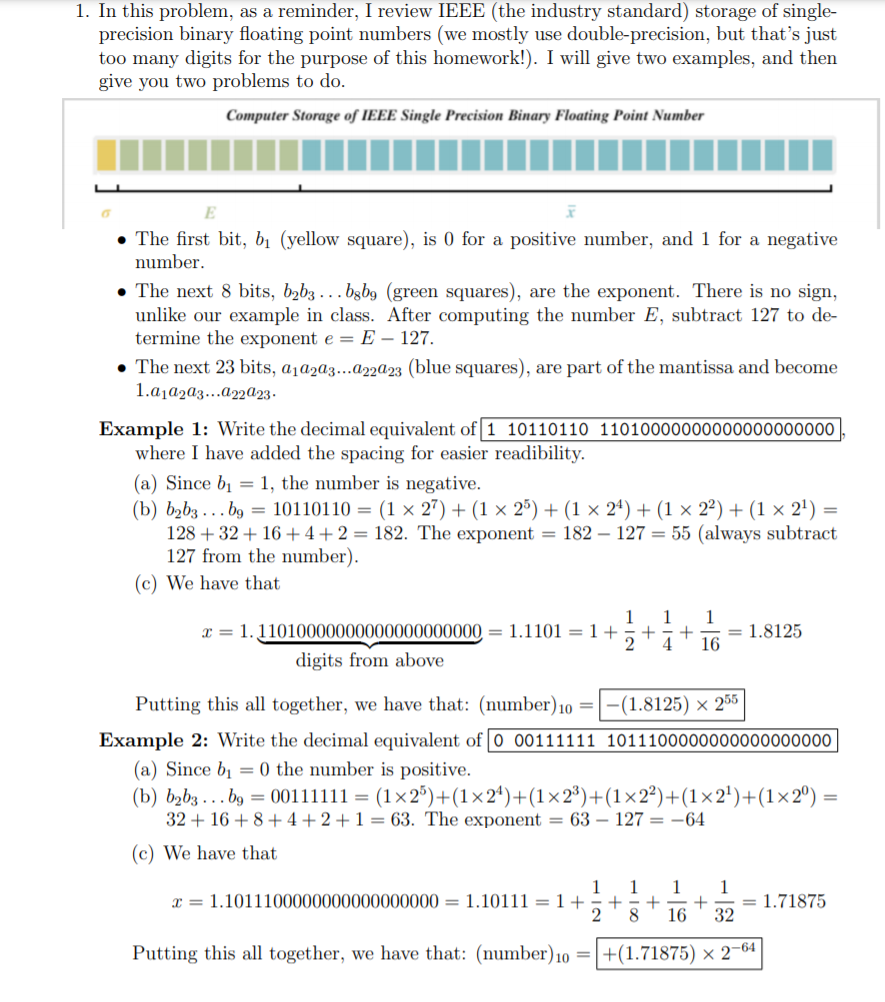
1. In this problem, as a reminder, I review IEEE (the industry standard) storage of single- precision binary floating point numbers (we mostly use double-precision, but that's just too many digits for the purpose of this homework!). I will give two examples, and then give you two problems to do. Computer Storage of IEEE Single Precision Binary Floating Point Number The first bit, b (yellow square), is 0 for a positive number, and 1 for a negative number. The next 8 bits, b2b3 ... bgbg (green squares), are the exponent. There is no sign, unlike our example in class. After computing the number E, subtract 127 to de- termine the exponent e = E - 127. The next 23 bits, QjQ223...A22023 (blue squares), are part of the mantissa and become 1.212223...222023 Example 1: Write the decimal equivalent of 1 10110110 11010000000000000000000), where I have added the spacing for easier readibility. (a) Since bj = 1, the number is negative. (b) b2b3 ... bg = 10110110 = (1 x 27) + (1 ~ 25) + (1 x 24) + (1 x 22) + (1 x 24) = 128 +32 + 16 + 4+2 = 182. The exponent = 182 127 = 55 (always subtract 127 from the number). (c) We have that 1 1 1 x = 1.11010000000000000000000 = 1.1101 = 1+++ = 1.8125 2 4 16 digits from above Putting this all together, we have that: (number) 10 = (1.8125) x 255 Example 2: Write the decimal equivalent of O 00111111 1011100000000000000000 (a) Since b = 0 the number is positive. (b) b2b3 ... bg = 00111111 = (1x 2)+(124)+(1x 23)+(1x22)+(1x24)+(1x2) = 32 + 16 + 8 +4+2+1 = 63. The exponent = 63 127 = -64 (c) We have that 1 1 1 1 x = 1.1011100000000000000000 = 1.10111 =1+ +-+ + = 1.71875 2 8 16 32 Putting this all together, we have that: (number) 10 +(1.71875) * 2-64 1. In this problem, as a reminder, I review IEEE (the industry standard) storage of single- precision binary floating point numbers (we mostly use double-precision, but that's just too many digits for the purpose of this homework!). I will give two examples, and then give you two problems to do. Computer Storage of IEEE Single Precision Binary Floating Point Number The first bit, b (yellow square), is 0 for a positive number, and 1 for a negative number. The next 8 bits, b2b3 ... bgbg (green squares), are the exponent. There is no sign, unlike our example in class. After computing the number E, subtract 127 to de- termine the exponent e = E - 127. The next 23 bits, QjQ223...A22023 (blue squares), are part of the mantissa and become 1.212223...222023 Example 1: Write the decimal equivalent of 1 10110110 11010000000000000000000), where I have added the spacing for easier readibility. (a) Since bj = 1, the number is negative. (b) b2b3 ... bg = 10110110 = (1 x 27) + (1 ~ 25) + (1 x 24) + (1 x 22) + (1 x 24) = 128 +32 + 16 + 4+2 = 182. The exponent = 182 127 = 55 (always subtract 127 from the number). (c) We have that 1 1 1 x = 1.11010000000000000000000 = 1.1101 = 1+++ = 1.8125 2 4 16 digits from above Putting this all together, we have that: (number) 10 = (1.8125) x 255 Example 2: Write the decimal equivalent of O 00111111 1011100000000000000000 (a) Since b = 0 the number is positive. (b) b2b3 ... bg = 00111111 = (1x 2)+(124)+(1x 23)+(1x22)+(1x24)+(1x2) = 32 + 16 + 8 +4+2+1 = 63. The exponent = 63 127 = -64 (c) We have that 1 1 1 1 x = 1.1011100000000000000000 = 1.10111 =1+ +-+ + = 1.71875 2 8 16 32 Putting this all together, we have that: (number) 10 +(1.71875) * 2-64







